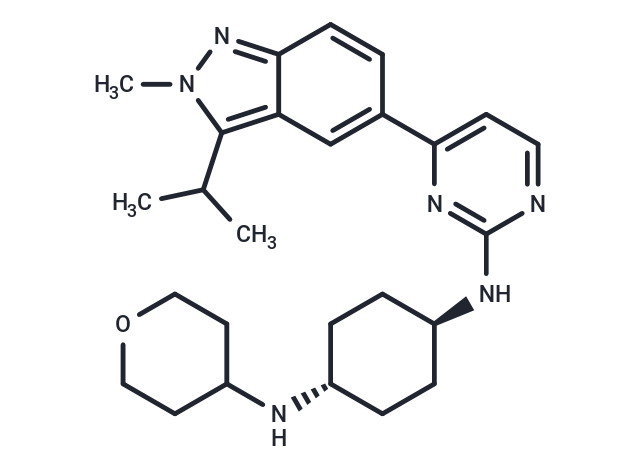Shopping Cart
- Remove All
 Your shopping cart is currently empty
Your shopping cart is currently empty

LY2857785 is a type I competitive and reversible ATP kinase inhibitor against CDK7/CDK8/CDK9 (IC50s: 246 nM/16 nM/11 nM).

| Pack Size | Price | Availability | Quantity |
|---|---|---|---|
| 1 mg | $48 | In Stock | |
| 2 mg | $68 | In Stock | |
| 5 mg | $113 | In Stock | |
| 10 mg | $183 | In Stock | |
| 25 mg | $372 | In Stock | |
| 50 mg | $596 | In Stock | |
| 100 mg | $959 | In Stock | |
| 1 mL x 10 mM (in DMSO) | $126 | In Stock |
| Description | LY2857785 is a type I competitive and reversible ATP kinase inhibitor against CDK7/CDK8/CDK9 (IC50s: 246 nM/16 nM/11 nM). |
| Targets&IC50 | CDK7:246 nM, CDK9:11 nM, CDK8:16 nM |
| In vitro | At the cellular level, LY2857785 inhibits CTD P-Ser2 and CTD P-Ser5 in U2OS cells (IC50s: 0.089 and 0.042 μM). However, LY2857785 only induces a moderate G2-M DNA content increase, from 35% to 55%, with EC50 0.135 μM. LY2857785 shows potent compound exposure- and time-dependent cell proliferation inhibition in MV-4-11, RPMI8226, and L363 cells. When incubated between 4 to 24 hours, the cell growth inhibition potency reaches a maximal effect at 8 hours for MV-4-11, RPMI8226, and L363 cells (IC50s: 0.04, 0.2, and 0.5 μM). LY2857785-induced cancer cell apoptosis is also time-dependent, reaching maximal potency at 8 hours with IC50 0.5 μM in L363 cells. |
| In vivo | In HCT116 xenograft tumor-bearing mice, LY2857785 potently demonstrates dose-dependent RNAP II CTD P-Ser2 inhibition (TED50: 4.4 mg/kg; TEC50: 0.36 μM), with a significant duration of inhibition for 3 to 6 hours at TED70 (8 mg/kg) in both HCT116 and MV-4-11 nude mice xenograft models. In the nude rat MV-4-11 xenograft model, LY2857785 similarly shows dose-dependent CTD P-Ser2 inhibition for 8 hours at TED70 (7 mg/kg) and TED90 (10 mg/kg). |
| Kinase Assay | CDK7 and CDK9 reaction mixtures contain 10 mM Tris-HCl (pH 7.4), 10 mM HEPES, 5 mM DTT, 10 μM ATP, 0.5 μCi 33p-ATP, 10 mM MnCl2, 150 mM NaCl, 0.01% Triton X-100, 2% DMSO, 0.05 mM CDK7/9ptide, and 2 nM CDK7/Mat1/cyclin H, or 2 nM CDK9/cyclin T1, respectively. CDK8/cyclin C reaction is performed in HEPES 30 mM, DTT 2 mM, MgCl2 5 mM, 0.015% Triton X-100, 5 μM ATP, and 400 nM of RBER-CHKStide containing 20 nM of enzyme. LY2857785 in DMSO is diluted serially 1:3 for dose-response. Reactions are carried out in 96-well polystyrene plates. The reactions are incubated at room temperature for 60 minutes and followed by termination with 10% H3PO4 or 10% trichloroacetic acid (TCA). For the filter binding assay, reactions are transferred to 96-well filter plates and measured by Microbeta scintillation counter. For ADP Transcreener Fluorescent Polarization Assays, reactions are quenched with ADP detection mix, incubated 2 hours at room temperature and then FP is measured at λex=610 nm, λem=670 nm on a Tecan Ultra 384 plate reader. The concentration of ADP product is calculated from millipolarization (μP) using a prepared ADP/ATP dilution series as a standard curve. Kinase profiling are carried out in 96-well polystyrene plates. Briefly, in a final volume of 25 μL the enzyme is incubated with the appropriate buffer, peptide substrate, and the diluted LY2857785. Reactions are initiated by the addition of ATP/[33P] and the ATP mix is incubated at room temperature for 40 minutes. Reactions are quenched with the addition of 5 μL of 3% phosphoric acid, 10 μL of the reaction are spotted onto a filter mat, washed 3 times for 5 minutes in 75 mM phosphoric acid and once in methanol. Once the filters are dry, they are submitted to scintillation counting. |
| Cell Research | Solid tumor cells are plated in poly-D-lysine coated and hematologic cell lines are seeded in noncoated 96-well plates overnight before being treated with LY2857785. Solid tumor cells are fixed with Prefer for 20 minutes at room temperature and permeated with 0.1% Triton X-100 in PBS for 15 minutes. Caspase-3 expression is measured by immunofluorescence with anti-activated caspase-3. Terminal deoxynucleotidyl transferase-mediated dUTP nick end labeling (TUNEL) activity is measured with In Situ Cell Death Detection Kit. Both assays are analyzed on Acumen Explorer laser-scanning fluorescence microplate cytometer. Hematologic tumor cells are assayed for cell viability with CellTiter-Glo Luminescent Cell Viability Assay. |
| Animal Research | For xenograft models, human cancer cells A375, U87MG, MV-4-11, and HCT116 are implanted into female nude rats or athymic nude female mice. The animals are dosed with saline, Rapamycin, or LY2857785, respectively. MV-4-11 xenografts in nude mice are treated by LY2857785 (4, 8, and 18 mg/kg) i.v. bolus. MV-4-11 xenografts in nude rats are treated with LY2857785 (3, 6, and 9 mg/kg) 4-hour i.v. infusion. An untreated vehicle control group is administered saline i.v. every 3 days. Flow cytometry analysis is conducted using Beckman Coulter's CXP software. Statistical significance of the effect of LY2857785 and/or control compounds is assessed by the Dunnett method, one-way ANOVA. |
| Molecular Weight | 448.6 |
| Formula | C26H36N6O |
| Cas No. | 1619903-54-6 |
| Smiles | CC(C)c1n(C)nc2ccc(cc12)-c1ccnc(N[C@H]2CC[C@@H](CC2)NC2CCOCC2)n1 |
| Relative Density. | 1.29 g/cm3 (Predicted) |
| Storage | Powder: -20°C for 3 years | In solvent: -80°C for 1 year | Shipping with blue ice. | |||||||||||||||||||||||||
| Solubility Information | DMSO: 10 mg/mL (22.29 mM), Sonication is recommended. | |||||||||||||||||||||||||
Solution Preparation Table | ||||||||||||||||||||||||||
DMSO
| ||||||||||||||||||||||||||

Copyright © 2015-2025 TargetMol Chemicals Inc. All Rights Reserved.